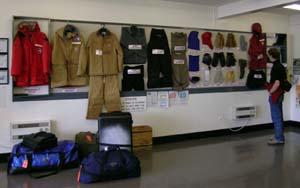
|
|
16 November, 2003
Gearing Up for the Ice
After a warm St. John’s School send off, I set off on a 25 hour odyssey
that took me from Houston, Texas, to Christchurch, New Zealand - a
gateway to Antarctica. After a year and a half of planning and dreaming
about going to Antarctica, I was finally underway! A meeting of eight
out of eleven 2003-2004 Mt. Erebus team members in Los Angeles brought
together a wide range of researchers, all of whom will be joining Dr.
Philip Kyle, the principal investigator from New Mexico Tech and his
graduate student Peter Kelly, both of whom arrived in Antarctica back on
November 3^rd . In addition to myself, an Earth Science teacher from
Houston, TX, the Mt. Erebus team includes Dr. Clive Oppenheimer, a
volcanologist from Cambridge, England, Dr. Kurt Panter, a petrologist
from Bowling Green State University in Ohio and his undergraduate
student Brian Winter, Dr. Jackie Caplan-Auerbach, a seismologist from
the Alaska Volcano Observatory, and three graduate students from New
Mexico Tech, Julie Calkins, Dawn Sweeney, and Shauna Mikelich.
As we eight weary travelers stumbled off the plane in Christchurch 15
hours after leaving Los Angeles, we were met by a Raytheon Polar Service
Company (RPSC) representative and, to our surprise, a National
Geographic film crew on a special about working conditions at South Pole
Station! The crew was documenting the arrival of a research team and
RPSC’s role in facilitating travel and equipment issue in Christchurch.
After filming our distinctive orange U.S. Antarctic Program (USAP)
luggage tags and a lecture on what we need to accomplish that afternoon,
the film crew accompanied us to the USAP Clothing Distribution Center (CDC).
All personnel working in Antarctica are issued Extreme Cold Weather
(ECW) gear before their deployment to the ice. As you enter the CDC, you
are greeted by a wall that names each arcticle of clothing issued to
Antarctic personnel. At first glance, the sheer volume of clothing
needed on the ice seems overwhelming (Figure 1)! Weighing in at a
whopping 40 pounds, our ECW bags include 6 pairs of wool-blend socks, 2
sets of polypropylene long underwear, 1 fleece jacket, 1 pair of fleece
pants, 1 pair of field trousers, 1 wind jacket, 1 pair of bib-snow
pants, 1 polar parka, 3 styles of hat, 4 pairs of glove lines, 7 types
of gloves/mittens, 1 pair of ski-goggles, and a pair of monsterous FDX
boots complete with 3 sets of insoles and 2 sets of quilted inner
booties - all of which need to be tried on before heading to the ice. We
spent the next hour or so donning each arcticle of clothing, inspecting
for broken zippers or mis-sized items, and putting on quite a fashion
show. Any problem items were simply exchanged for one of the multitude
of clothing items housed in the CDC facility (Figure 2). While the room
temperature was comfortably cool in street clothes, wearing a full
ensemble of ECW gear indoors was a sweaty venture!
After ensuring a good fit for our ECW gear, we packed and labeled our
bags for Monday morning’s attempted ice flight. With any luck our ice
flight will be as well-orchestrated as the streamlined gear
distribution. Stay tuned for the next installment “High Flying
Adventure” to find out if we make it to Antarctica on our first
flight attempt, or are turned back by bad weather as several flights had
been earlier this season.

1. Figure 1 - We received a guided tour of the Extreme Cold Weather (ECW) clothing wall and an explanation of each item issued by the US Antarctic Program's (USAP) Clothing Distribution Center (CDC). --

2. Figure 2 - The vast CDC clothing stock room ensures a good fit for each ECW item regardless of your size or shape. --
Contact the TEA in the field at
.
If you cannot connect through your browser, copy the
TEA's e-mail address in the "To:" line of
your favorite e-mail package.
|
